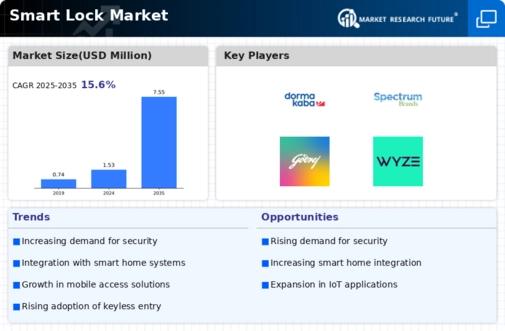Market Analysis
In-depth Analysis of Smart Lock Market Industry Landscape
The Smart Lock market is characterized by dynamic and evolving market dynamics, driven by a combination of technological advancements, consumer preferences, and industry trends. One key dynamic is the continuous innovation in smart lock technologies. As companies invest in research and development, new features and functionalities are regularly introduced to enhance security, convenience, and connectivity. From biometric authentication and remote monitoring to integration with smart home ecosystems, these innovations not only attract tech-savvy consumers but also contribute to the overall growth and competitiveness of the Smart Lock market.
Consumer awareness and the increasing adoption of smart home technologies are fundamental market dynamics influencing the Smart Lock industry. As more consumers recognize the benefits of smart locks in terms of convenience, security, and remote access, the demand for these devices continues to rise. The growing inclination towards creating connected homes, where various devices communicate seamlessly, further propels the market dynamics. Smart locks, as a key component of smart home ecosystems, become integral to the modern lifestyle, influencing market growth.
Security concerns and the need for robust protection against unauthorized access contribute significantly to the market dynamics of smart locks. Traditional locks are increasingly seen as vulnerable, prompting consumers to seek more advanced and technologically sophisticated solutions. Smart locks, with features like biometric authentication, secure encryption methods, and real-time monitoring, address these concerns and align with the contemporary need for heightened security. As security remains a top priority for consumers, it continues to be a driving force shaping the dynamics of the Smart Lock market.
Interoperability and integration play a pivotal role in the evolving market dynamics of smart locks. As the smart home ecosystem expands, consumers seek devices that can seamlessly communicate and work together. Smart locks that integrate with virtual assistants, security cameras, and other smart home devices offer a comprehensive solution, driving their market demand. Compatibility with popular platforms and ecosystems enhances the overall user experience, contributing to the success and sustainability of smart locks in the market.
The competitive landscape is another dynamic aspect of the Smart Lock market. With an increasing number of companies entering the space, competition is fierce. Companies strive to differentiate themselves through product features, pricing strategies, and brand positioning. This competition fosters continuous innovation and improvement in smart lock technologies, benefiting consumers with a wide range of choices and driving the overall market dynamics.
Regulatory factors and standards compliance also influence the market dynamics of smart locks. Adherence to security and privacy standards, along with certification from relevant authorities, is crucial for gaining consumer trust. Government regulations and industry standards set the framework for product quality and safety, shaping the market by establishing a baseline for acceptable practices and influencing market dynamics.
Economic factors, including disposable income and consumer spending patterns, contribute to the market dynamics of smart locks. Economic stability and increased disposable income enable more consumers to invest in smart home technologies, including smart locks. Conversely, economic downturns may impact market growth temporarily as consumers prioritize essential expenditures over discretionary purchases, illustrating the sensitivity of the Smart Lock market to economic conditions.







Leave a Comment